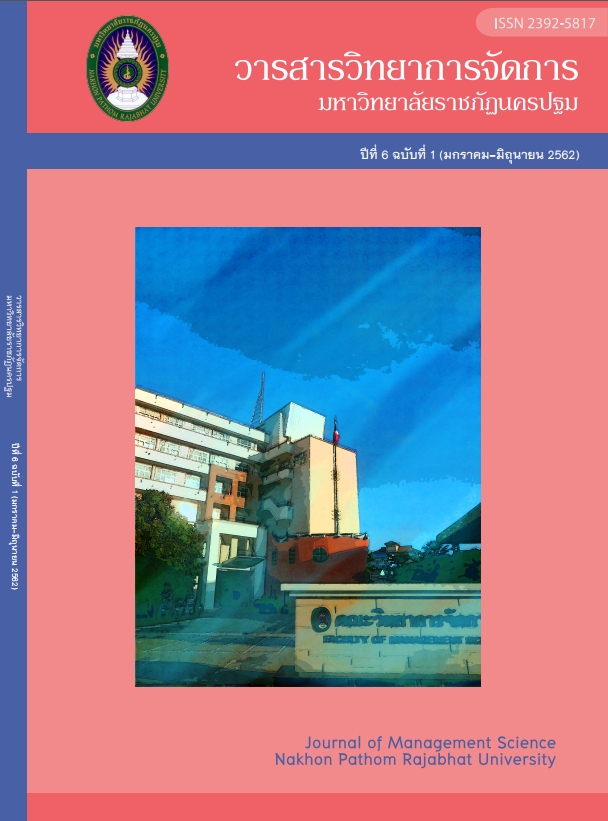Personnel development in the ministry of industry and commerce, LAO People’s Democratic Republic .
Main Article Content
Abstract
The objectives of this study were (1) Factors affecting Personnel Development in the Ministry of Industry and Commerce; (2) Problems of Personnel development; and (3) The model of Personnel development in the Ministry of Industry and Commerce.
This research forms were Mixed Research using 1) Qualitative Research including document research and In-depth interviews with 4 senior executives, the tool used was a structured interview and group discussions with 4 middle level executives and 4 operational levels and Quantitative Research by using questionnaires as a tool to inquire personnel of the Ministry of Industry and Trade, which were a total population of 420 people. Statistics such as multiple regression analysis, frequency, percentage, mean, standard deviation and content analysis
Major Findings : On the factors affecting Personnel Development in the Ministry of Industry and Commerce it were found that with statistical significance at 0.01 level namely, leadership, curriculum, personnel development Personnel development evaluation and knowledge of information technology capabilities. The personnel development policy and administrative resources no statistical significance. Can create predictions, predict the level of personnel development success. The prediction equation in the form of raw score: Yˆ = 0.662 + 0.192 (Leadership) + 0.120 (Personnel Development Program) + 0.091 (Information Technology Competency) + 0.294 (Personnel Development Evaluation) and The prediction equation in the form of standard score: Zˆ = 0.247 (Leadership) + 0.139 (Personnel Development Program) + 0.104 (Information Technology Competency) + 0.340 (Personnel Development Evaluation) (2) Problems of Personnel development were found that problems and obstacles of personnel development include, Budget constraints, Lack of coordination, The capacity is limited, There were no courses in international trade and industry law, The payroll of personnel were not consistent with the cost of living. Inspection restrictions, The creation of information technology networks were not covered in the backcountry and Personnel still lack knowledge and experience in working with foreigners or international organizations. (3) The model of Personnel development in the Ministry of Industry and Commerce are 4 sides 1) Leadership 2) Curriculum Personnel Development 3) Evaluation and 4) Information Technology and The success of personnel development has components 7 sides 1) Personnel planning 2) Development and training 3) Compensation 4) Information technology 5) Promoting roles of personnel 6) Working environment and 7) Cooperation with international.
Article history : Received 02 February 2019
Revised 05 March 2019
Accepted 7 March 2019
SIMILARITY INDEX = 1.39
Article Details
The views and opinions of the article appearing in this journal are those of the author. It is not considered a view and responsibility of the editorial staff.
References
กระทรวงภายใน. (2554). เลขที่ 01/ภน นครหลวงเวียงจันทน์ ลงวันที่ 7 พฤศจิกายน 2554. ม.ป.ท.
กระทรวงอุตสาหกรรมและการค้า. สปป.ลาว (2560). นโยบายในการบริหารงาน. [ออนไลน์] ค้นเมื่อ 24 มีนาคม 2560, จาก https:// laoftpd.com/index.php?option= com
กรมเจรจาการค้าระหว่างประเทศ. (2556). WTO ไฟเขียวรับ “สปป.ลาว” เข้าสมาชิกใหม่ลำดับที่ 158 [ออนไลน์] ค้นเมื่อ 20 มีนาคม 2560, จาก https://www.dtn.go.th/index.php.
กรมนโยบายการค้าต่างประเทศ Foreign Trade Policy Department กระทรวงอุตสาหกรรมและการค้า สปป.ลาว(2560). ปัญหาและอุปสรรคในการพัฒนาบุคลากร. สาธารณรัฐประชาธิปไตยประชาชนลาว.
กรมส่งเสริมการค้าระหว่างประเทศ. (2561). ข้อมูล สปป.ลาว. [ออนไลน์] ค้นเมื่อ 2 มกราคม 2561, จาก https://www.ditp.go.th/contents_attach/168658/ 168658.pdf.
กรมส่งเสริมการส่งออก กระทรวงพาณิชย์ (2554). คู่มือการค้าและการลงทุน สาธารณรัฐประชาธิปไตยประชาชนลาว. ม.ป.ท.
คำสั่งกระทรวงอุตสาหกรรมและการค้า สปป.ลาว (2556). เลขที่ 0084/อค ลงวันที่ 15 มกราคม 2556 เรื่อง การจัดตั้งแผนขยายกำลังและแผนปฏิบัติพัฒนาอุตสาหกรรมและแผนงาน ในปี 2012 – 2013.สาธารณรัฐประชาธิปไตยประชาชนลาว. ม.ป.ท.
ธีระ รุญเจริญ. (2550). ความเป็นมืออาชีพในการจัดและบริหารการศึกษายุคปฏิรูปการศึกษา. กรุงเทพฯ : แอล. ที. เพรส จํากัด.
บุญเลิศ ไพรินทร์ (2548). พฤติกรรมการบริหารงานบุคคล. กรุงเทพฯ : สำนักคณะกรรมการข้าราชการพลเรือน.
เบญยาศิริ งามสะอาด (2560). การพัฒนาทรัพยากรมนุษย์ขององค์การบริหารส่วนตำบลตามแนวทางการบริหาร จัดการแนวใหม่ขององค์การบริหารส่วนตำบล ในเขตจังหวัดปทุมธานี. วารสารวิทยาลัยนครราชสีมา.11(1) ,242-254
ประภาส บุญไชย (2550). การบริหารงานวิชาการด้านการปฏิรูปหลักสูตรและกระบวนการเรียนการสอนของผู้บริหารสถานศึกษาขั้นพื้นฐาน ช่วงชั้นที่ 1-2 สังกัดสำนักงานเขตพื้นที่การศึกษาสุพรรณบุรี,วิทยานิพนครุศาสตรมหาบัณฑิต สาขาวิชาการบริหารการศึกษา, มหาวิทยาลัยราชภัฏกาญจนบุรี.
เมธินี อิ่นแก้ว (2553). การศึกษาแนวทางการพัฒนาบุคลากรของสานักงานพื้นที่พิเศษ เชียงใหม่ไนท์ซาฟารี. [ออนไลน์] ค้นเมื่อ 18 มีนาคม2560, จาก https://www.mpec.cmru.ac.th/mpec2012/ option/files/003/.../1364310454.
ยาเบ็น เรืองจรูญศรี (2552). ความรู้ทั่วไปเกี่ยวกับหลักสูตร. [ออนไลน์] ค้นเมื่อ 2 มกราคม 2560, จาก https://www.kroobannok.com/blog/39838.
วิชญาภา เมธีวรฉัตร (2558). รูปแบบการพัฒนาทรัพยากรมนุษย์เชิงพุทธของมหาวิทยาลัยราชภัฏ ภาคเหนือตอนล่าง. ปริญญาพุทธศาสตรดุษฎีบัณฑิต (รัฐประศาสนศาสตร์) มหาวิทยาลัยมหาจุฬาลงกรณราชวิทยาลัย.
ศิริวรรณ เสรีรัตน์ สมชาย หิรัญกิตติ และธนวรรธ ตั้งสินทรัพย์ศิริ.(2550). การจัดการและพฤติกรรมองค์การ. กรุงเทพฯ : ธีระฟิล์ม และไซเท็กซ์.
สุรินทร์ พิศสุวรรณ อดีตเลขาธิการสมาคมประชาชาติแห่งเอเชียตะวันออกเฉียงใต้ (2555). การบรรยายพิเศษ เรื่อง การพัฒนทรัพยากรมนุษย์สู่ประชาคมอาเซียน. วันที่ 10 มีนาคม 2555 ณ มหาวิทยาลัยรามคำแหง
เสกสรรค์ สนวา (2560). การพัฒนาบุคลากรแนวใหม่ : ผลลัพธ์ที่มีต่อองค์การ. [ออนไลน์] ค้นเมื่อ 4 มีนาคม 2560, จาก https://www.stou.ac.th/ study/sumrit/4-55(500)/page1-4-55(500).html.
เสกสิทธิ คูณศรี (2555). ความสำคัญของการพัฒนาองค์กรด้วยเทคโนโลยีสารสนเทศ. [ออนไลน์] ค้นเมื่อ 9 มิถุนายน 2560, จาก https://www.chanthaburi.go.th/redcross/article/IT.htm.
สุรมงคล นิ่มจิตต์ และ ธีระวัฒน์ จันทึก (2559). การพัฒนารูปแบบกลยุทธ์ด้านทรัพยากรมนุษย์เพื่อความได้เปรียบ ตามมาตรฐานการประกันคุณภาพการศึกษา ของกลุ่มมหาวิทยาลัยเทคโนโลยีราชมงคล. RMUTT Global Business and Economics Review.11 (2), 129-143
Ajay S. & DR. Nirmala, C. (2011). HRD CLIMATE AND JOB SATISFACTION: An Empirical Investigation University School of Management, Kurukshetra University. Kurukshetra International Journal of Computing and Business Research. 2 (2). 169-171.
Kaufman ,B. E. (2012). Human Resource Management Research in the United States: A Failing Grade After 30 Years? Retrieved May 15,2017 from https://amp.aom.org/content/ 26/2/12.abstract.
Kirkpatrick, D. L. Evaluation of Training. In R. L.Craig (Ed.), (1987). Training and development handbook : A guide to human resource development. (2nd ed.) New York : McGraw-Hill.
Lao People’s Democratic Republic Peace Independence Unity Prosperity. (2016).8 th FIVE-YEAR NATIONAL SOCIOECONOMIC DEVELOPMENT PLAN (2016–2020) (Officially approved at the VIIIth National Assembly’s Inaugural Session, 20–23 April 2016, Vientiane) Ministry of Planning and Investment June, 2016.
Nadler L Ed., (1984). The Handbook of Human resources Development New York : John Wiley and Sons.
Nadler. L., (1992). Enveloping Human Resources. Houston : Gulf.
Nelson, D. L., & Quick, J. C. Organization. (1997). Behavior. (2nd ed.). New York : Harper & Row.
Tabibi S.J., Khah S.V., Nasiripour A.A., Vahdat S. and Hessam S. (1985). Factors Affecting Human Resource Development in the Iranian Social Security Organization’s Hospitals, World Applied Sciences Journal. 15 (2): 164-173.
The American Heritage Dictionary. (2018). Leadership. Retrieved March 10, 2018 from https://www.ahdictionary.com/


